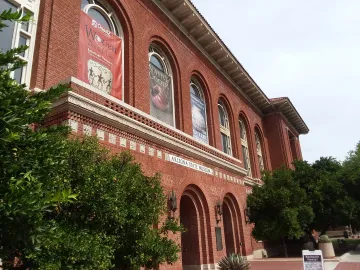Collections Curation

Arizona State Museum's north building
ASM's collections are held in trust for the people of the state of Arizona. Numbering more than 3 million
objects, these include 300,000 catalogued archaeological artifacts, 40,000 ethnographic artifacts, 525,000 photographic negatives and original prints, 90,000 volumes of rare and hard-to-find titles, 6,000 maps, 1,500 linear feet of archival documents, and more than 1,000 sound recordings. In addition, the archaeological repository (the largest and busiest state-run repository in the nation) currently curates more than 38,000 cubic feet of research materials.
ASM is home to:
- the worlds largest and most comprehensive collection of Native North American basketry -- more than 35,000 specimens spanning 7,000 years to present;
- the world’s largest, most comprehensive, and best documented collection of Southwest Indigenous pottery, comprising 24,000 whole-vessels dating back more than 2,000 years;
- three separate collections federally recognized and each given the designation of American Treasures: pottery, basketry, and photography;
- one of the nation’s top Navajo textile collections, including some of the earliest, rarest, and largest examples;
- more than 500 outstanding examples of Mexican folk masks and and more than 500 katsina dolls; and
the archival papers and original field notes of giants of Southwest anthropology such as Emil Haury, Grenville Goodwin, Edward Spicer, and Clara Lee Tanner.
Public Programs
In addition to engaging university students through classroom, laboratory, and field instruction, ASM offers a full calendar of public programs on the ancient Indigenous and modern-day Native cultures of the region, sharing its expertise and collections with visitors of all ages through exhibits, school programs, lectures, hands-on activities, workshops, and travel tours.
SEE CURRENT OFFERINGS
Preservation
Arizona State Museum’s (ASM) conservation laboratory, established in the late 1970s, was the first, and remains the only, museum conservation laboratory in the state dedicated to the preservation of and technical research on anthropological collections.
A center of research and professional training, ASM’s conservation lab is where science and culture connect. It is a shining example of the type of interdisciplinary research that is possible at the University of Arizona (UA). ASM conservators collaborate with museum colleagues, faculty in other UA units as well as colleagues across the nation and around the globe.
Since 1983, the state-of-the-art facility has been under the direction of conservator and professor Nancy Odegaard, Ph.D. Dr. Odegaard and her team conduct and facilitate research that has transformed the discipline of object conservation through the use of chemistry, engineering, scientific method, and anthropological principles. Dr. Odegaard’s research leadership has resulted in the development of internationally recognized educational curricula for the care and handling of archaeological and ethnographic collections, a textbook on chemical characterization tests for objects of art and archaeology, and the first emergency response manual for university museums. Ground-breaking research has been shared with the world through books, chapters, journal articles, videos, presentations, and posters. Today, the lab continues to provide preventive and interventive conservation of ASM's vast collections, serves the public through workshops and queries, instructs scores of conservation students, and continues to conduct cutting-edge research, currently in areas such as nano-particle technology, imaging technology, and frozen technology.
ASM conservators also conduct hands-on preservation work in the field, teach in classroom settings, and lecture extensively. There is a long list of professional researchers, students, and community volunteers eager to participate in the lab’s work.
Research and Teaching
Scholarship at ASM cuts across many disciplines. ASM scholars:
- conduct excavations to understand the lifeways of ancient peoples, including the Hohokam of central and southern Arizona and the ancestral Hopi people of northern Arizona;
- study the ancient migration of people;
- research the origins and influence of the ancient people of northern Mexico;
- advance knowledge of Spanish and Mexican water rights in the US Southwest;
- research, edit, and publish documentary histories of Native people during the Spanish and Mexican periods (1540-1848);
- investigate prehistoric human adaptations to desert ecosystems;
- conduct research on prehistoric and historic uses of animals by southwestern peoples, and;
- use research findings to establish the highest standards of conservation practices.
State-Mandated Programs
Arizona State Museum is the state's official archaeological repository. ASM is the largest and busiest state-run curation facility in the nation, growing by 1000 cubic feet per year, and currently holding 38,000 cubic feet of material.
Our state-mandated responsibilities are these:
- ASM administers the Arizona Antiquities Act, making it the permitting authority for archaeological activity conducted on more than 9.5 million acres of state land. Objects and associated documentation produced as a result of that activity fall under ASM's curatorial responsibilities.
- Under the Arizona Antiquities Act, ASM assists other state agencies, and in some case federal authorities, in the investigation and prosecution of crimes that result in damage to the archaeological record.
- ASM administers the state statues that protect human burials on both state and private lands, and works with federal agencies and tribal communities to implement the federal Native American Graves Protection and Repatriation Act (NAGPRA).





